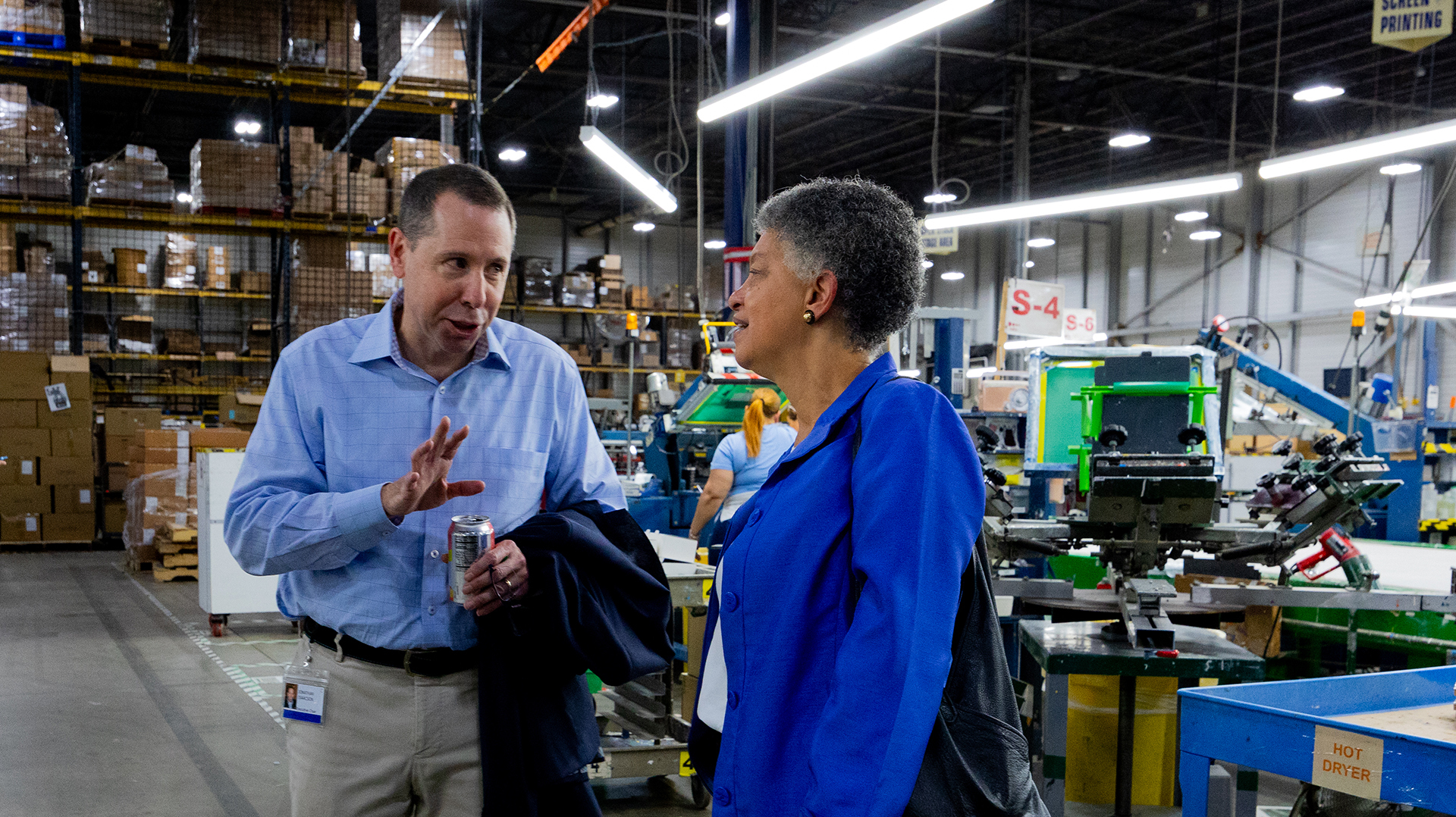At 10-year mark, Boston Fed team visits former mill city to celebrate its resurgence 
In Lawrence, Collins joins leaders to hail progress, get insights on regional economy 
A decade ago, Lawrence became one of New England’s first “Working Cities,” joining several small Massachusetts cities with rich – but faded – industrial pasts in a new community development initiative.
On Tuesday, Federal Reserve Bank of Boston President Susan M. Collins visited Lawrence, where the Bank has been involved since the Working Cities Challenge began in 2014. Some say the program sparked significant changes in the former mill city.
“It started with Working Cities Challenge, and that really got people together and catalyzed some efforts,” said Julie Thurlow, an executive committee member of the Lawrence Partnership, an economic development group started by local businesses and community leaders.
Thurlow is also president and CEO of Reading Cooperative Bank, which hosted a morning discussion about the city’s progress and prospects with Collins and representatives from the Lawrence Partnership at the bank’s Mill District branch.
Later, Collins attend a 10th anniversary celebration of the Partnership, at which she delivered a speech that included her national economic outlook. She also talked about how collaboration between people across different sectors in Lawrence has proven essential.
“Complex issues cannot be solved by one sector, one organization, or one person,” she said. “Successful collaboration requires attention to process. It requires new voices at the table to expand (insight).”
Lawrence leader: Collaboration is “the story of this city”
Lawrence, a city of about 88,000 near the New Hampshire border, was built on the economic power of its massive textile mills along the Merrimack River. Today, it’s a majority Hispanic/Latino community (82%).
The loss of its historical industrial base by the mid-20th century ushered in some tough decades for Lawrence, and it fit the profile of the kind of city targeted by the Working Cities Challenge (which is now part of the larger Working Places program).
The Working Places model focuses on cultivating partnerships in sectors that might not naturally interact – say business and social services. Then, they tackle chronic local problems together.
In Lawrence, the Working Cities Challenge team focused on helping the parents of public-school children find jobs with higher income potential.
Working Cities Challenge team leader Jessica Andors is also on the executive committee of the Lawrence Partnership, which represents a range of local interests – from the families who own the historic mills, to relatively new businesses and immigrants. Andors said that kind of collaboration has always been a focus in Lawrence because it’s a community of immigrants that needs to work together.
“(Collaboration) really is the story of this city and this room,” she told Collins.
6 images

Collins sees progress in fight against inflation
Collins’ speech at the Lawrence Partnership celebration focused in part on the Fed’s continuing efforts to control inflation, which she likened to “a tax that affects us all.”
She said that while the Fed had made significant progress, inflation has stubbornly remained well above the Fed’s 2% target. But she hailed recent data that showed modest progress.
“In my view, the data suggest an economy with demand and supply coming into better balance, which is what’s required in order to restore price stability,” she said. “But this process may just take more time than previously thought.”
Collins heard about the impacts of inflation during a discussion with Lawrence entrepreneurs and small business owners at a meeting after the Lawrence Partnership event.
Alberto Nunez of the property management firm Syramad Properties, Inc., talked to Collins about the proverbial “light at the end of the tunnel.”
“That tunnel, for the cost of living and rent, is dark for me,” he said. “I don’t know where we’re going.”
Collins said she’s heard similar worries around New England, which emphasizes to her the importance of the Fed’s work to slow inflation and create a more stable economic environment.
“It takes time, and it takes patience, and patience is really hard when people are struggling,” Collins said.
Executives highlight impacts of high inflation, high turnover
The final event of the day was a discussion held at promotional products supplier Gemline. There, regional executives from the health care, food, apparel, and manufacturing sectors talked about struggling to keep prices and wages competitive in an inflationary environment. They said turnover is a challenge, driven in part by a lack of affordable child care and adequate public transportation.
Dr. Guy Fish, CEO of the Greater Lawrence Health Center, said the stresses from COVID-19 pushed a lot of their workers out. And he said the recent graduates they’ve hired to replace them are very sensitive to cost-of-living pressures that have been exacerbated by inflation. They’ll leave quickly for relatively small raises.
Collins said the Fed’s aim, and the heart of its 2% inflation target, is to create a business environment where price increases and their cascading effects are no longer the key concern.
“That’s what I’m looking for, an environment where people are thinking about how to be more productive, how to train, how to develop, how to open doors,” she said. “They’re not thinking about inflation.”
Media Inquiries? 
Contact our media relations team. We connect journalists with Boston Fed economists, researchers, and leadership and a variety of other resources.

 About the Authors
About the Authors
Jay Lindsay is a member of the communications team at the Federal Reserve Bank of Boston.
Email: jay.lindsay@bos.frb.org
Site Topics
Keywords
- Susan M Collins ,
- Lawrence Community Works ,
- workforce development ,
- inflation ,
- economic development ,
- Cross-sector collaboration ,
- collaboration ,
- working cities challenge ,
- Working Places initiative






